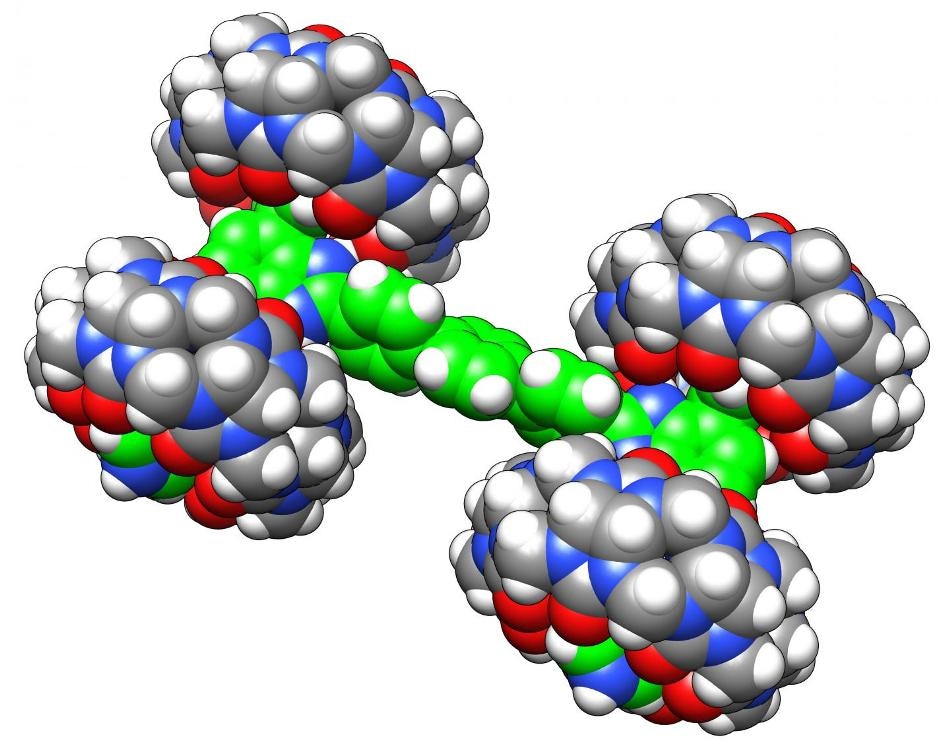Aug 24 2017
The world's shortest race by distance, a fraction of the width of a strand of human hair, was run on silver and gold tracks and took a massive 30 hours. The typical racing fan might have missed it since the vehicles were invisible to the naked eye.
However, the April "nanorace" was an immense success for Scientists working at the nanoscale. It encouraged interest in molecular machines and resulted in an unexpected new discovery, reports the team that entered a nano-sized "monster truck."
 Ohio University's nano-sized monster truck led to a curious finding. CREDIT Eric Masson, Ph.D.
Ohio University's nano-sized monster truck led to a curious finding. CREDIT Eric Masson, Ph.D.
On August 23rd, 2017, the Researchers presented their nanocar research at the 254th National Meeting & Exposition of the American Chemical Society (ACS). ACS, the largest scientific society in the whole world, is hosting the meeting until August 24th Nearly 9,400 presentations will be featured on a variety of science topics
The overarching goal was to advertise nanoscience to the public. Then there was the technical challenge of manipulating multiple nanocars at the same time using a scanning tunneling microscope, or STM, instrument. Additionally, every team had its own goal. Ours was to see if we could deposit an intact supramolecular assembly onto a surface, and control its motion.
Eric Masson, Ph.D.
The team from Ohio University was co-led by Masson and Saw-Wai Hla, Ph.D. Together, they designed and constructed the largest car at about 3.5 nm in length. This car, formally called the Bobcat Nanowagon, comprised of a pseudorotaxane H-shaped frame with four comparatively large cucurbituril molecules as wheels. It was ironically dubbed a monster truck because of the size. However, unlike normal vehicles, this car did not have a motor. Thus, the researchers used the STM instrument in Hla's lab to move the nanocar.
We incorporated positive charge receptors in the car. So if we injected a positive charge in the STM tip pointed at the car, there would be repulsion, and the car would move. We found it worked very well.
Saw-Wai Hla, Ph.D.
The competition, billed as the first-ever nanocar race, was conducted at the French National Center for Scientific Research (CNRS) in Toulouse on April 28th. Six teams from three different continents entered their molecule-sized racers. But, the Ohio team kept their nanowagon in Hla's lab and then "drove" it remotely from CNRS since the STM instrument in Toulouse only comprised of four tips, where each was capable of controlling only one nanocar.
"My understanding is that this was a first," Hla says. "We manipulated the car at the atomic scale from half a globe away."
Hla and Masson's nanowagon traveled 43 nm on the gold track before it got stuck due to a power blip in the Midwest and a specifically rough section of the track. Despite the fact that it did not complete the course, it still managed to go farther than three other contestants, earning the team a third-place showing.
According to Masson and Hla, the Ohio team discovered something fascinating as a result of the race. The nanowagon was assembled by them by first suspending the chassis molecules in water, followed by adding the wheel molecules and finally evaporating the water. About 70% of the resulting structures appeared to be like two-wheeled hover boards, a few comprised of three wheels and about 10% had all four wheels. They were shocked to find that very few wheels were not connected to anything
That means that it was easier to break the chassis, a covalent bond, than to break the noncovalent bonds between the chassis and the wheels. That's completely counterintuitive because typically a noncovalent bond is much weaker than a covalent bond. It's a theoretical curiosity.
Eric Masson, Ph.D.
It remains unknown as to how this information might apply eventually to molecular machines in the future even though many Scientists predict the possibility of using such small vehicles in data storage and electronics. Masson and Hla together highlight that the work is still in its early stages. It is essential for Scientists to understand how molecules perform at the atomic scale before applications come along.
"Our excitement is really about the fundamental science," Hla says. "This is just the beginning."